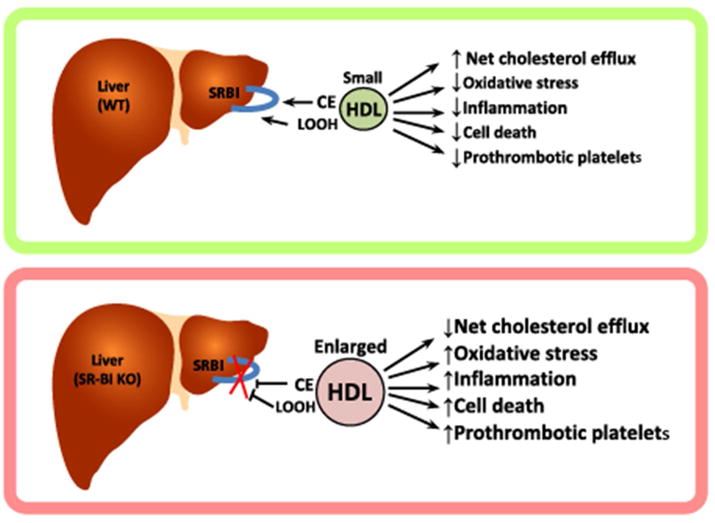Scavenger receptor class B member 1 (SCARB1), encoded by the SCARB1 gene, is also known as SRB1, SR-BI or CD36. SCARB1 is identified as a member of the Class B family of Scavenger Receptor proteins. The structure of SCARB1 is predicted to contain two transmembrane domains, one intracellular N- and C-termini and an extracellular loop with a large extracellular domain (ECD) where there are six cysteine (Cys) residues involved in disulfide bond formation, and those intramolecular disulfide bonds appear to maintain the receptor in a conformation integral to its cholesterol transport functions. SCARB1 is expressed in numerous cell types/tissues, including the liver and adrenal.
| Basic Information of SCARB1 | |
| Protein Name | Scavenger receptor class B member 1 |
| Gene Name | SCARB1, CD36L1, CLA1 |
| Aliases | SRB1, CD36 and LIMPII analogous 1, CLA-1, CD36 antigen-like 1, Collagen type I receptor, thrombospondin receptor-like 1, SR-BI, CD_antigen: CD36 |
| Organism | Homo sapiens (Human) |
| UniProt ID | Q8WTV0 |
| Transmembrane Times | 2 |
| Length (aa) | 552 |
| Sequence | MGCSAKARWAAGALGVAGLLCAVLGAVMIVMVPSLIKQQVLKNVRIDPSSLSFNMWKEIPIPFYLSVYFFDVMNPSEILKGEKPQVRERGPYVYREFRHKSNITFNNNDTVSFLEYRTFQFQPSKSHGSESDYIVMPNILVLGAAVMMENKPMTLKLIMTLAFTTLGERAFMNRTVGEIMWGYKDPLVNLINKYFPGMFPFKDKFGLFAELNNSDSGLFTVFTGVQNISRIHLVDKWNGLSKVDFWHSDQCNMINGTSGQMWPPFMTPESSLEFYSPEACRSMKLMYKESGVFEGIPTYRFVAPKTLFANGSIYPPNEGFCPCLESGIQNVSTCRFSAPLFLSHPHFLNADPVLAEAVTGLHPNQEAHSLFLDIHPVTGIPMNCSVKLQLSLYMKSVAGIGQTGKIEPVVLPLLWFAESGAMEGETLHTFYTQLVLMPKVMHYAQYVLLALGCVLLLVPVICQIRSQVGAGQRAARADSHSLACWGKGASDRTLWPTAAWSPPPAAVLRLCRSGSGHCWGLRSTLASFACRVATTLPVLEGLGPSLGGGTGS |
SCARB1 is a receptor for high-density lipoprotein (HDL), and it promotes selective HDL-cholesteryl ester (HDL-CE) hepatic uptake, playing a critical role in lipoprotein metabolism. It has been reported that SCARB1 plays a key role in reverse cholesterol transport, promoting the hepatic selective uptake of cholesterol and facilitating the secretion of cholesterol into bile. Additionally, SCARB1 can also promote the elimination of excess body cholesterol via biliary cholesterol secretion. SCARB1 is also shown to play a significant role in macrophage cholesterol flux that may partly account for its effects on atherogenesis. SCARB1 can interact with several molecules to activate different pathways. For instance, HDL/SCARB1 interaction activates the PI3K and Erk1/2 pathways; PDZK1/SCARB1 interaction activates eNOS and endothelial cell migration; Src/SCARB1 interaction activates MAPK, p38, JNK, FAK, and GTPases.
 Fig.1 Hepatic SR-BI: Selective Uptake of HDL Lipids Regulates HDL Function. (Linton, 2017)
Fig.1 Hepatic SR-BI: Selective Uptake of HDL Lipids Regulates HDL Function. (Linton, 2017)
This article shows that detrimental effects of SR-BI deficiency on cardiac structure and function can be nullified by hepatocyte-specific SR-BI transfer, which restores HDL metabolism.
This article indicates that the inhibition of SR-BI attenuates the tumorous behaviors of clear cell renal cell carcinoma (ccRCC), expression of metastasis and AKT pathway-related proteins, suggesting SR-BI may serve as a potential prognostic biomarker and therapeutic target for ccRCC.
This study suggests that quercetin-induced up-regulation of SR-BI and subsequent lipid uptake in hepatocytes might contribute to its beneficial effects on cholesterol homeostasis and atherogenesis.
This article indicates that SR-BI-mediated transcytosis in brain microvascular endothelial cells is distinct from uptake and signaling pathways described for this receptor in other cell types.
This report indicates that high SR-BI expression in melanoma is linked with increased cellular glycosylation and hence is essential for a metastasis-specific expression signature.
We provide custom membrane protein preparation services for worldwide customers. Leveraging by our advanced Magic™ membrane protein production platform, we are able to present target membrane protein in multiple active formats. Our professional scientists are happy to help you find an ideal method and make your project a success. Aided by our versatile Magic™ anti-membrane protein antibody discovery platform, we also provide customized anti-SCARB1 antibody development services.
Creative Biolabs provides high-quality membrane protein preparation service to facilitate the development of worldwide customer’s research. During the past years, we have successfully established a powerful Magic™ membrane protein platform which enables us to provide a series of membrane protein preparation services. For more detailed information, please feel free to contact us.
Reference
All listed services and products are For Research Use Only. Do Not use in any diagnostic or therapeutic applications.